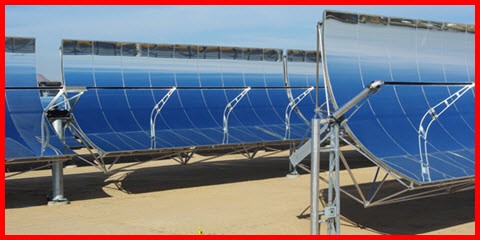.
California Farmers Are Looking Forward To Many more Of These Plants To Be Built
The first solar thermal desalination is about to break ground as the permitting process is finalized.
Compared to the large controversial Carlsbad plant which costs a billion dollars using a reverse osmosis process to produce 50 million gallons of water a day, this solar design looks a lot more economical costing 30 million and producing 5 million gallons a day.
WaterFX will use a 24-MW trough-type solar thermal field supplied by NREL-collaborator SkyFuel to create direct steam from the sun to run multi-effect distillation, desalinating enough agricultural water for reuse to keep 2,000 acres of farmland irrigated each year.
Agricultural Desalination
WaterFX Chairman Aaron Mandell, who previously founded Oasys Water, a Massachusetts provider of desalination and water-treatment technologies, said he focused on reusing agricultural drainage water because agriculture is California’s biggest water user. Selenium and other natural agricultural salts build up in soil, eventually making farming impossible.
“The agricultural sector uses about 80 percent of all the water in California,” Mandell explained. “If only 20 percent of the water is being used for municipalities, and you reduce that water consumption by 50 percent, you’ve only made a 10 percent impact overall. Reducing agricultural use has a much bigger impact.”
Last year WaterFX completed a six-month demonstration project that convinced the Panoche Water District to go ahead with the commercial plant. “The water district has been monitoring the pilot project and they’re very happy with the results,” Mandell said.
Desalination Technology
WaterFX uses thermal desalination, which leaves only about 7 gallons of highly concentrated brine per 100 gallons of intake water.
The Central Valley has ancient seafloor containing minerals and metals that are in the ground naturally, but as the fresh water is being used up, the sediment is concentrated.
This semi-solid brine of naturally occurring salts, which includes gypsum that is used in construction, boron, and selenium that is used in semiconductors, is worth millions, according to Mandell.
“We can actually separate and refine certain components for resale,” he says.
“We deal with farmers who have suffered substantial yield losses just due to the low quality of the groundwater, and they have to pump from deeper and deeper depths as the water table gets drawn down,” Mandell said. “They are in pretty dire straits. They are now having their second year in history of zero water allocation.”
WaterFX expects its second solar thermal desalination plant to be approved this year and operate in 2016.
There are a lot more details in the source article. Image is from the source article



